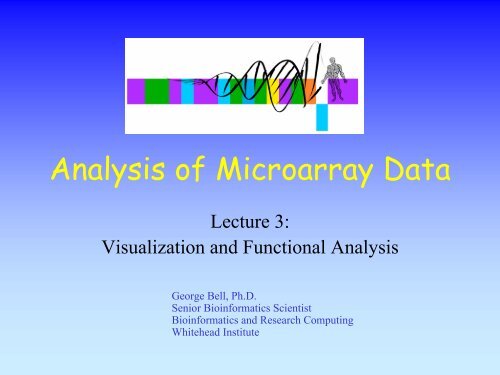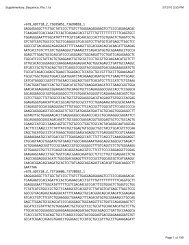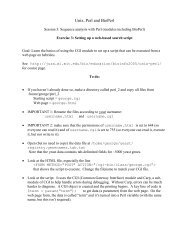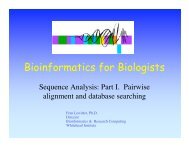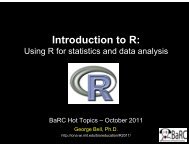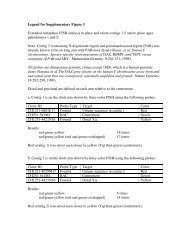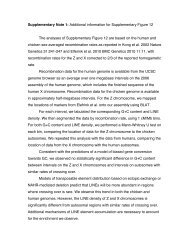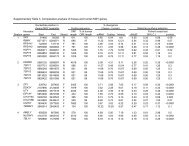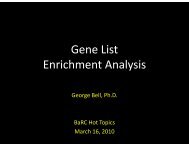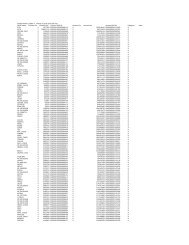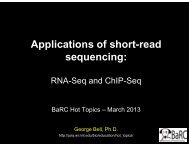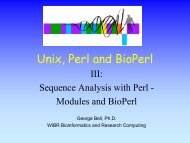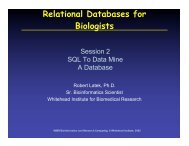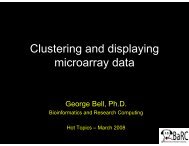Analysis of Microarray Data - Bioinformatics and Research ...
Analysis of Microarray Data - Bioinformatics and Research ...
Analysis of Microarray Data - Bioinformatics and Research ...
You also want an ePaper? Increase the reach of your titles
YUMPU automatically turns print PDFs into web optimized ePapers that Google loves.
<strong>Analysis</strong> <strong>of</strong> <strong>Microarray</strong> <strong>Data</strong><br />
Lecture 3:<br />
Visualization <strong>and</strong> Functional <strong>Analysis</strong><br />
George Bell, Ph.D.<br />
Senior <strong>Bioinformatics</strong> Scientist<br />
<strong>Bioinformatics</strong> <strong>and</strong> <strong>Research</strong> Computing<br />
Whitehead Institute
Outline<br />
•Review<br />
• Visualizing all the data<br />
• What to do with a set <strong>of</strong> interesting genes?<br />
– Basic annotation<br />
– Comparing lists<br />
– Genome mapping<br />
– Obtaining <strong>and</strong> analyzing promoters<br />
– Gene Ontology <strong>and</strong> pathway analysis<br />
– Other expression data<br />
WIBR <strong>Microarray</strong> Course, © Whitehead Institute, 2006<br />
2
Generic <strong>Microarray</strong> Pipeline<br />
• Design experiment<br />
• Prepare samples <strong>and</strong> perform hybridizations<br />
• Quantify scanned slide image<br />
• Calculate expression values<br />
• Normalize<br />
• H<strong>and</strong>le low-level expression values<br />
• Merge data for replicates<br />
• Determine differentially expressed genes<br />
• Cluster interesting data<br />
not<br />
covered<br />
in course<br />
WIBR <strong>Microarray</strong> Course, © Whitehead Institute, 2006<br />
3
Review<br />
• Preliminary filtering?<br />
• Measuring differential expression:<br />
• Correcting for multiple hypothesis testing<br />
– Fold change, t-test, ANOVA<br />
– Bonferroni, False Discovery Rate, etc.<br />
• Filtering; identifying “interesting” genes<br />
• Distance measures for clustering<br />
• Clustering/segmentation types <strong>and</strong> methods<br />
• What is the best analysis pipeline?<br />
– Why are you doing the experiment?<br />
– Are you being reasonable with the statistics?<br />
WIBR <strong>Microarray</strong> Course, © Whitehead Institute, 2006<br />
4
Why draw figures?<br />
• Get a global perspective <strong>of</strong> the experiments<br />
• Quality control: check for low-quality data<br />
<strong>and</strong> errors<br />
• Compare raw <strong>and</strong> normalized data<br />
• Compare controls: are they homogeneous?<br />
• Help decide how to filter data<br />
• Look at a subset <strong>of</strong> data in detail<br />
WIBR <strong>Microarray</strong> Course, © Whitehead Institute, 2006<br />
5
Intensity histogram<br />
Median = 6.6<br />
Median = 100<br />
WIBR <strong>Microarray</strong> Course, © Whitehead Institute, 2006<br />
6
Intensity histogram<br />
• Most genes have low expression levels<br />
• Using log 2 scale to transform data<br />
– more normal distribution<br />
– more helpful interpretation<br />
• One way to observe overall intensity <strong>of</strong> chip<br />
• How to choose genes with “no” expression?<br />
WIBR <strong>Microarray</strong> Course, © Whitehead Institute, 2006<br />
7
Intensity scatterplot<br />
WIBR <strong>Microarray</strong> Course, © Whitehead Institute, 2006<br />
8
Intensity scatterplot<br />
• Compares intensity on two colors or chips<br />
• Genes with similar expression are on the<br />
diagonal<br />
• Use log-transformed expression values<br />
• Genes with lower expression<br />
– noisier expression<br />
– harder to call significant<br />
WIBR <strong>Microarray</strong> Course, © Whitehead Institute, 2006<br />
9
R-I <strong>and</strong> M-A plots<br />
WIBR <strong>Microarray</strong> Course, © Whitehead Institute, 2006<br />
10
R-I <strong>and</strong> M-A plots<br />
• Compares intensity on two colors or chips<br />
• Like an intensity scatterplot rotated 45º<br />
R (ratio) = log(chip1 / chip2)<br />
I (intensity) = log(chip1 * chip2)<br />
M = log 2 (chip1 / chip2)<br />
A = ½(log 2 (chip1*chip2))<br />
• Popularized with lowess normalization<br />
• Easier to intrepret than an intensity<br />
scatterplot<br />
WIBR <strong>Microarray</strong> Course, © Whitehead Institute, 2006<br />
11
Volcano plot<br />
WIBR <strong>Microarray</strong> Course, © Whitehead Institute, 2006<br />
12
Volcano plot<br />
• Scatterplot showing differential expression<br />
statistics <strong>and</strong> fold change<br />
• Visualize effects <strong>of</strong> filtering genes by both<br />
measures<br />
• Using fold change vs. statistical measures<br />
for differential expression produce very<br />
different results<br />
WIBR <strong>Microarray</strong> Course, © Whitehead Institute, 2006<br />
13
Boxplots<br />
Raw <strong>and</strong> median-normalized log 2 (expression values)<br />
WIBR <strong>Microarray</strong> Course, © Whitehead Institute, 2006<br />
14
Boxplots<br />
• Display summary statistics about the<br />
distribution <strong>of</strong> each chip:<br />
–Median<br />
– Quartiles (25% <strong>and</strong> 75% percentiles)<br />
– Extreme values (>3 quartiles from median)<br />
– Note that mean-normalized chips wouldn’t<br />
have the same median<br />
– Easy in R; much harder to do in Excel<br />
WIBR <strong>Microarray</strong> Course, © Whitehead Institute, 2006<br />
15
Chip images<br />
•Affymetrix<br />
U95A chip<br />
hybridized with<br />
fetal brain<br />
•Image generated<br />
from .cel file<br />
•Helpful for<br />
quality control<br />
WIBR <strong>Microarray</strong> Course, © Whitehead Institute, 2006<br />
16
Heatmaps<br />
experiments<br />
genes<br />
WIBR <strong>Microarray</strong> Course, © Whitehead Institute, 2006<br />
17
Using distance measurements<br />
Genes with most similar pr<strong>of</strong>iles to GPR37<br />
WIBR <strong>Microarray</strong> Course, © Whitehead Institute, 2006<br />
18
Functional <strong>Analysis</strong>: intro<br />
• After data is normalized, compared, filtered,<br />
clustered, <strong>and</strong> differentially expressed genes<br />
are found, what happens next?<br />
• Driven by experimental questions<br />
• Specificity <strong>of</strong> hypothesis testing increases<br />
power <strong>of</strong> statistical tests<br />
• One general question: what’s special about<br />
the differentially expressed genes?<br />
WIBR <strong>Microarray</strong> Course, © Whitehead Institute, 2006<br />
19
Annotation using sequence databases<br />
• Gene data can be “translated” into IDs from a<br />
wide variety <strong>of</strong> sequence databases:<br />
– LocusLink, Ensembl, UniGene, RefSeq, genome<br />
databases<br />
– Each database in turn links to a lot <strong>of</strong> different types <strong>of</strong><br />
data<br />
– Use Excel or programming tools to do this quickly<br />
• Web links, instead <strong>of</strong> actual data, can also be used.<br />
• What’s the difference between these databases?<br />
• How can all this data be integrated?<br />
WIBR <strong>Microarray</strong> Course, © Whitehead Institute, 2006<br />
20
Venn diagrams<br />
• Show intersection(s) between at least 2 sets<br />
Typical figure<br />
More informative figure<br />
WIBR <strong>Microarray</strong> Course, © Whitehead Institute, 2006<br />
21
Mapping genes to the genome<br />
Genomic locations <strong>of</strong><br />
differentially expressed genes<br />
Human genome, May 2004<br />
WIBR <strong>Microarray</strong> Course, © Whitehead Institute, 2006<br />
22
Promoter extraction<br />
• Prerequisite <strong>of</strong> any promoter analysis<br />
• Requires a sequenced genome <strong>and</strong> a complete,<br />
mapped cDNA sequence<br />
• “Promoter” is defined in this context as upstream<br />
regulatory sequence<br />
• Extract genomic DNA using a genome browser:<br />
UCSC, Ensembl, NCBI, GBrowse, etc.<br />
• Functional promoter needs to be determined<br />
experimentally<br />
WIBR <strong>Microarray</strong> Course, © Whitehead Institute, 2006<br />
23
Promoter analysis<br />
• TRANSFAC contains curated binding data<br />
• Transcription factor binding sites can be<br />
predicted<br />
– matrix (probabilities <strong>of</strong> each nt at each site)<br />
– pattern (fuzzy consensus <strong>of</strong> binding site)<br />
• Functional sites tend to be evolutionarily<br />
conserved<br />
• Functional promoter activity needs to be<br />
verified experimentally<br />
WIBR <strong>Microarray</strong> Course, © Whitehead Institute, 2006<br />
24
Gene Ontology<br />
• GO is a systematic way to describe protein (gene)<br />
function<br />
• GO comprises ontologies <strong>and</strong> annotations<br />
• The ontologies:<br />
– Molecular function<br />
– Biological process<br />
– Cellular component<br />
• Ontologies are like hierarchies except that a<br />
“child” can have more than one “parent”.<br />
• Annotation sources: publications (TAS),<br />
bioinformatics (IEA), genetics (IGI), assays (IDA),<br />
phenotypes (IMP), etc.<br />
WIBR <strong>Microarray</strong> Course, © Whitehead Institute, 2006<br />
25
Gene Ontology enrichment analysis<br />
• Unbiased method to ask question, “What’s so<br />
special about my set <strong>of</strong> genes?”<br />
• Obtain GO annotation (most specific term(s)) for<br />
genes in your set<br />
• Climb an ontology to get all “parents” (more<br />
general, “induced” terms)<br />
• Look at occurrence <strong>of</strong> each term in your set<br />
compared to terms in population (all genes or all<br />
genes on your chip)<br />
• Are some terms over-represented?<br />
Ex: sample:10/100 pop1: 600/6000 pop2: 15/6000<br />
WIBR <strong>Microarray</strong> Course, © Whitehead Institute, 2006<br />
26
Pathway enrichment analysis<br />
• Unbiased method to ask question, “Is my set<br />
<strong>of</strong> genes especially involved in specific<br />
pathways?”<br />
• First step: Link genes to pathways<br />
• Are some pathways over-represented?<br />
• Caveats<br />
– What is meant by “pathway"?<br />
– Multiple DBs with varied annotations<br />
– Annotations are very incomplete<br />
WIBR <strong>Microarray</strong> Course, © Whitehead Institute, 2006<br />
27
Enrichment analysis on sorted<br />
expression data<br />
• Input 1: complete sorted gene list<br />
– no threshold value or definition <strong>of</strong> significance<br />
• Input 2: set <strong>of</strong> biologically meaningful gene<br />
sets<br />
– pathway, genome<br />
location, function, ...<br />
• Is the rank <strong>of</strong> genes from<br />
any gene set in your sorted<br />
list non-r<strong>and</strong>om?<br />
• Example: GSEA<br />
Broad Institute<br />
WIBR <strong>Microarray</strong> Course, © Whitehead Institute, 2006<br />
28
Comparisons with<br />
other expression studies<br />
• Array repositories: GEO (NCBI), ArrayExpress<br />
(EBI), WADE (WIBR)<br />
• Search for genes, chips, types <strong>of</strong> experiments,<br />
species<br />
• View or download data<br />
• Normalize but still expect noise<br />
– Check medians <strong>and</strong> distribution <strong>of</strong> data<br />
• It’s much easier to make comparisons within an<br />
experiment than between experiments<br />
WIBR <strong>Microarray</strong> Course, © Whitehead Institute, 2006<br />
29
Summary<br />
• Plots: histogram, scatter, R-I, volcano, box<br />
• Other visualizations: whole chip, heatmaps,<br />
bar graphs, Venn diagrams<br />
• Annotation to sequence DBs<br />
• Genome mapping<br />
• Promoter extraction <strong>and</strong> analysis<br />
• GO <strong>and</strong> pathway enrichment analysis<br />
• Comparison with published studies<br />
WIBR <strong>Microarray</strong> Course, © Whitehead Institute, 2006<br />
30
More information<br />
• Course page:<br />
– http://jura.wi.mit.edu/bio/education/bioinfo2006/arrays/<br />
• Bioconductor short courses: http://www.bioconductor.org/<br />
• BaRC analysis tools:<br />
– http://jura.wi.mit.edu/bioc/tools/<br />
• Gene Ontology Consortium website:<br />
– http://www.geneontology.org/<br />
• Causton HC et al. <strong>Microarray</strong> Gene Expression <strong>Data</strong><br />
<strong>Analysis</strong>: A Beginner’s Guide. Blackwell, 2003.<br />
• Parmigiana G et al. The <strong>Analysis</strong> <strong>of</strong> Gene Expression <strong>Data</strong>:<br />
Methods <strong>and</strong> S<strong>of</strong>tware. Springer, 2003.<br />
WIBR <strong>Microarray</strong> Course, © Whitehead Institute, 2006<br />
31
Exercises<br />
• Graphing all data<br />
– Scatterplot<br />
– R-I (M-A) plot<br />
– Volcano plot<br />
• Functional analysis<br />
– Annotation<br />
– Comparisons<br />
– Genome mapping<br />
– Promoter extraction <strong>and</strong> analysis<br />
– GO <strong>and</strong> pathway analysis<br />
– Using other expression studies<br />
WIBR <strong>Microarray</strong> Course, © Whitehead Institute, 2006<br />
32


